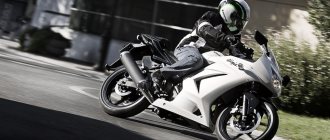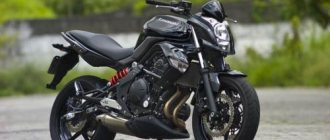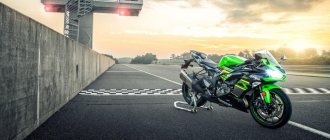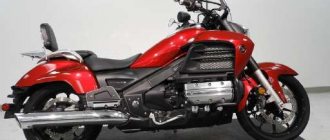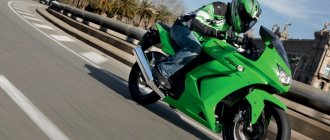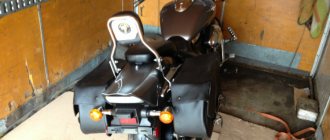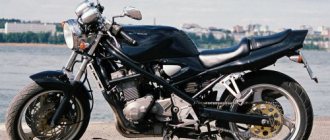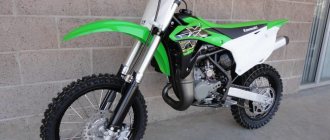Model overview
The engineers have worked hard to put together a motorcycle that combines power and agility perfectly.
Thanks to the 600cc engine, this bike reaches a maximum speed of 280 km/h, but its low weight makes it agile on the most difficult turns.
Now a few laps on this bike have become an exciting ride at incredible speed.
In addition to ideal weight and excellent speed, the Kawasaki Ninja 600 received its main parameters from the Ninja ZX-6RR, which had previously been released in limited quantities.
So, let's get started with a detailed review of this racing car.
- Frame. Most likely, even on the drawings, the engineers had an idea to create a frame with maximum harmony between a rigid landing and flexible control.
Thanks to this design, at the beginning of a turn, synchronization with the steering wheel is absolutely maximum.
To create such a balance, it was necessary to calculate the location of the pendulum and the position of the motor.
The Kawasaki Ninja 600 ZX 6R has a frame made of a single unit, thanks to which the motor moves simultaneously with the frame. This design allows you to move all the weight evenly, gaining greater speed.
- Engine. The main aspect of the engine is the slipper clutch. When making a sharp jerk on a turn, the pilot will not need to fear falling.
- Suspension. In a motorcycle, the suspension can be adjusted depending on the type of road on which the bike will be ridden.
- The brakes are powerful.
- The landing is sporty.
Model description
When creating this car, Japanese engineers did a good job and assembled a device that perfectly combines and complements each other with enormous power and extraordinary maneuverability. Due to the 0.6-liter engine, this bike is capable of achieving enormous speed: the Kawasaki Ninja 600 easily accelerates to 280 km/h. Thanks to its low weight, it handles well and easily overcomes even the most difficult turns.
This model is built on the basis of the Ninja ZX-6RR, from which it received not only ideal weight and good speed performance, but also other basic parameters.
The frame of the racing car is created as harmoniously as possible - there is both a rigid landing and fairly flexible control. Due to the design features, at the beginning of a turn you can observe absolute synchronization with the steering wheel. To create such a balance, Japanese engineers very accurately and carefully calculated the location of the pendulum, as well as the position of the engine.
The frame is a solid block. This feature makes it possible to move weight more evenly, while gaining maximum speed.
As for the power plant of the Kawasaki Ninja 600, the slipper clutch can be identified as the main aspect of the design. At the moment of a sharp jerk on a turn, the pilot does not have to worry about falling.
The suspension is adjusted depending on the type of road on which this Japanese speed monster will be driven. Also included are very powerful brakes and a sporty riding position.
Owners' opinions
We all know that no matter how beautiful the device looks, before purchasing it, you need to read the reviews of motorcyclists who managed to purchase the model they liked. Owners characterize Ninja bikes as a very fast option, capable of accelerating up to 180 km/h, so they recommend spending money on buying a helmet
Some car enthusiasts note the rather expensive spare parts for Kawasaki and focus on safety, because driving over 150 km/h can only be accomplished by experienced bikers. Others do not notice the shortcomings at all, praising the motorcycle’s fast acceleration and low fuel consumption
When purchasing one of the Kawasaki bikes, you must remember that you are getting a high-quality motorcycle from a reliable Japanese manufacturer that will be able to meet all your expectations, delivering only positive emotions from owning the machine.
What do the owners say?
Judging by the reviews from the owners of such bikes, there is little difference between a new version and a used one in good condition. However, even used owners still advise buying a new car if possible.
It is not always possible to fully understand how the previous owner used the motorcycle. And this affects its future condition, maintenance and safety of the rider.
It was noticed that the bike picks up speed well and passes through oncoming air flows, but its handling is not the best in its class. However, this is sufficient to enjoy a more or less comfortable and safe ride at not the highest speeds.
Owners also note that this bike has a convenient instrument panel, which is clearly visible in the dark and fog. No need to bend over to see the indicators
And this is critically important at high speeds, as is clear from any first-person video on a sportbike
In conclusion, it is worth noting that the Kawasaki ZX-6R (636) is suitable for sports class connoisseurs. Especially if you like modern bikes and not the sports classics of the eighties. The car is responsive and expressive. But you can only do this after a weaker sportbike, so as not to get into a dangerous situation.
Exterior design of the sportbike
The Kawasaki Ninja 600 has an impressive appearance with a sporty style.
The first thing that catches your eye in the foreground are the high-brightness dual headlights.
The style is also complemented by the Ram Air air intake system, which is placed in the center of the bike.
Turn signals are built into the front fairing.
The wing at the front has acquired an aerodynamic shape.
At the rear, the turn signals are quite small and cone-shaped. The rear light is equipped with bright LEDs.
It precisely projects the shape of the rear fairing and is located high above the road level, which ensures maximum visibility of the motorbike on the road.
The instrument panel is made in a racing style and consists of:
- Gear adjustment indicator.
- Digital speedometer.
- Diagram tachometer.
- Digital thermometer.
- Stopwatch.
- Watch.
- Indicator lamps.
- Odometer.
In addition, it can be noted that the exhaust system is made of stainless steel. The sporty style is reflected in the passenger footrests.
The mounting panel was made in the form of a triangle with special cutouts. The bike frame has a black finish.
Design
The Kawasaki Ninja 600 motorcycle, in addition to technical characteristics, is distinguished by impressive external data. Naturally, the style is completely sporty. The first thing your eye immediately catches is the high-brightness front optics. The sporty style is also complemented by an air intake system - it is located in the center of the front part.
Direction indicators are installed in the front fairing. The front wing has an aerodynamic shape. As for the rear turn signals, they are small, cone-shaped. Even then, the Japanese equipped the rear light with LEDs.
On the instrument panel, which is also made in a sporty racing design, you can see gear adjustment indicators, a speedometer, a tachometer, and a thermometer. Also for the convenience of the rider, there is a clock and a stopwatch on the dashboard. To monitor the condition of the main engine components, there are indicator lamps on the panel.
The exhaust system is made of stainless steel. Elements of sporty style can be seen in the passenger footrests.
Ninja 250 wins the hearts of racers
This model from the famous Japanese manufacturer was destined to become both a sports and a traditional motorcycle for drivers of various skill levels.
Featuring a 249cc twin-cylinder engine producing 27.6 hp, the sportbike is capable of delivering 1.4 miles in 14.6 seconds. In addition, it is difficult not to note the significant advantages of the motorcycle, such as ease of control and low seat position. Comfortable movement on city streets on one of the most stable motorcycles is also ensured by the classic landing and a two-piston disc brake, which is characterized by high sensitivity to touching the brake lever. One look at this car, thought out to the smallest detail, is enough to realize that this is the most stylish and ergonomic motorcycle in its class.
In 2008, fans of the 250 model could notice significant changes in it, which affected both the technical characteristics and design of the motorcycle, and also influenced the increase in its cost. The developers decided to attract professional racers to their motorcycle by increasing the wheel size and front suspension. Innovations also affected the appearance of the motorcycle, which began to look more modern.
Notable Features
Among its competitors, the Kawasaki Ninja stood out with its strong chassis, excellent handling and amazing speed, thanks to which it practically destroyed its rivals.
In the eighties, 243 km/h was an absolute record for the class of road bikes.
In addition to its extreme power, the model was also distinguished by the phenomenal reliability of the DOHC power plant, which had four cylinders, sixteen valves and liquid cooling, as well as four carburetors, known as Keihin CVK4.
With an engine capacity of 908 cc, it produced 115 hp. s., and in the modification for European countries - 100 l. With.
Motorcycle modifications
- ZX600F (1995-1997). The very first model in the line. Equipped with a Ram-Air inertial pressurization system.
- ZX600G (1998-1999). Restyling with new carburetors and improved front brakes.
- ZX600J (2000-2002). Modified and slightly strengthened engine, improved electrics and different wheels.
- ZX636A (2002). Modification with increased to 636 cc. see engine size.
- ZX-6RR (2003-2004). A different appearance and many technical changes.
- ZX636B (2003-2004). In many ways similar to the above modification, but differs in a different design.
- ZX-6N, aka ZX-6R 636 (2005-2006). Another restyling, increased maximum engine speed, power 130 hp. Engine capacity is 636 cubic meters instead of 599.
- ZX-600P (2007-2008). Return to the 599 cc engine, deeply reworked.
- ZX-600R (2009-2012). Updated design, new fork and slipper clutch. In 2013, production of a version with a 636 cc engine began in parallel.
- ZX-6R 2019+. It is a restyling of the 2013 model, differing mainly in appearance. Still in production today.
Specifications
The Kawasaki Ninja motorcycle has the following dimensions:
- Length - 222 cm;
- Width - 74 cm;
- Height (in the village) - 122 (79) cm;
- Wheelbase - 150 cm.
Its curb weight is 234 kilograms, and the gas tank capacity is 22 liters.
The frame of the GPZ 900 R is made of steel tubes and has a central spine. The chassis is made with a large margin of safety.
The UNI-TRAK suspension is equipped with a monoshock absorber. The gearbox is six-speed.
| Characteristics of Kawasaki Ninja GPZ 900 R | |
| Power unit | |
| Number of valves per cylinder | 4 |
| Number and arrangement of cylinders | 4 row |
| Number of cycles | 4 |
| Gas distribution system | DOHC |
| Cooling system | Liquid |
| Stroke/Bore (mm) | 55,0 / 72,5 |
| Engine capacity (cc. cm) | 908 |
| Max. power, (hp / kW / rpm) | 115 / 83,9 / 9500 |
| Compression | 11,01 |
| Transmission | |
| Number of gears | 6 |
| Drive | Chain |
| Brake system | |
| Front | Disc (280 mm) double |
| Behind | Single disc (270 mm) |
| Chassis | |
| Front wheel | 120 / 80-16 |
| Rear wheel | 130 / 80-18 |
| Suspension | UNI-TRAK with monoshock absorber |
| Fuel consumption | |
| Extra-urban cycle (l/100km) | 3,08 |
Conclusion
Belonging to the mid-sized category does not make the Kawasaki Ninja 600 worse than its “liter” counterparts and competitors. It's just a different bike, and one that can compete with more powerful sportbikes in most situations. On the track, of course, this is a completely different class, but during everyday driving around the city or on the highways there is practically no difference. More precisely, there is a difference in dynamics, but it begins to be felt only at high speeds, which even the most desperate pilots do not reach every day. This Kawasaki motorcycle costs significantly less than any “liter”, but it can give no less adrenaline.
Specifications
| Maximum engine power: | from 105 to 136 HP |
| Torque: | 65.0 - 71.0 Nm |
| Working volume: | 599 cm³ – RR version, 636 cm³ – 636 cm3 version |
| Motor type (cylinder arrangement, number of strokes): | 4-cylinder, 4-stroke, in-line |
| Number of cylinders: | 4 |
| Number of valves: | |
| Intake type (Injector / Carburetor): | |
| Bore and stroke: | |
| Starting system (Electric starter, kick starter): | |
| Maximum speed in km/h: | 248-264 km/h |
| Cooling system: | Liquid |
| Transmission (gearbox): | 6-speed, manual |
| Clutch (Dry / Wet): | |
| Drive unit: | Chain |
| Frame: | Aluminum |
| Chassis | |
| Suspension (front/rear travel): | |
| Brakes (Front/Rear): | |
| Wheels / Tires / Rubber: | |
| Dimensions and weight | |
| Dimensions (Length / Width): | |
| Seat height: | |
| Ground clearance: | |
| Curb weight: | |
| Wheelbase: | 1390 - 1415 mm |
| Weight: | 188 - 206 kg |
| Fuel tank capacity: | 17 - 18 l. |
| Battery capacity: | |
| Year of release: | |
| Country of Origin: |
Brake system
The brake discs are large here. Their width is 6 mm and diameter is 300 mm. They are made of stainless steel.
Thus, the brake force will be very strong each time you apply them.
It often happens that even experienced riders find it difficult to discern which gear is currently in use while riding.
To prevent such situations, the digital display is installed in a large size.
It is able to instantly display all the most important information for the rider - speed and gear number.
The ZX-6R model has cylindrical airbox guides. They help ensure accurate spraying from the fuel injectors.
As a result, better fuel atomization improves combustion efficiency. Accordingly, the engine output will be greater.
Competition
The creators of the Kawasaki Ninja 600 set themselves the goal of designing a motorcycle that would have significant sprinting potential. Competition in the world of racing and sports bikes is consistently high, and although the Kawasaki brand is considered dominant in many respects, it has long been breathing down its neck with Italian sprint models like the Aprilia Tuono or German Motorrad sportbikes with two-cylinder boxer engines, which are capable of double your speed in circuit racing without crashing off the track.
Brief history of the model
Model
: Kawasaki ZX-6R (Europe, North America).
Factory designation
: ZX600-F1.
Model
: Kawasaki ZX-6R (Europe, North America).
Factory designation
: ZX600-F2.
Model
: Kawasaki ZX-6R (Europe, North America).
Factory designation
: ZX600-F3.
Model
: Kawasaki ZX-6R (Europe, North America).
Factory designation
: ZX600-G1, ZX600-H1.
Model
: Kawasaki ZX-6R (Europe, North America).
Factory designation
: ZX600-G2, ZX600-H2.
Model
: Kawasaki ZX-6R (all markets).
Factory designation
: ZX600-J1.
Model
: Kawasaki ZX-6R (all markets).
Factory designation
: ZX600-J2.
Model
: Kawasaki ZX-6R;
Kawasaki ZX-6R (636) (all markets). Factory designation
: ZX600-J3; ZX636-A1.
Model
: Kawasaki ZX-6R;
Kawasaki ZX-6R (636) (Europe, North America). Factory designation
: ZX600-K1; ZX636-B1.
Model
: Kawasaki ZX-6R;
Kawasaki ZX-6R (636) (Europe, North America). Factory designation
: ZX600-M1; ZX636-B2.
Model
: Kawasaki ZX-6R;
Kawasaki ZX-6R (636) (Europe, North America, Asia). Factory designation
: ZX600-N1; ZX636-C1.
Model
: Kawasaki ZX-6R;
Kawasaki ZX-6R (636) (Europe, North America, Asia). Factory designation
: ZX600-N6F; ZX636C6F, ZX636D6F.
Model
: Kawasaki ZX-6R (Europe, North America, Asia).
Factory designation
: ZX600P7F.
Model
: Kawasaki ZX-6R (Europe, North America, Asia).
Factory designation
: ZX600P8F.
Model
: Kawasaki ZX-6R (Europe, North America, Asia).
Factory designation
: ZX600R9F.
Model
: Kawasaki ZX-6R (Europe, North America, Asia).
Factory designation
: ZX600RAF.
Model
: Kawasaki ZX-6R (Europe, North America, Asia).
Factory designation
: ZX600RBF.
Model
: Kawasaki ZX-6R (Europe, North America, Asia).
Factory designation
: ZX600RCF.
Model
: Kawasaki ZX-6R;
Kawasaki ZX-6R 636 + ABS (Europe, North America, Asia). Factory designation
: ZX600RDF; ZX636EDF + ZX636FDF.
Model
: Kawasaki ZX-6R;
Kawasaki ZX-6R 636 + ABS (Europe, North America, Asia). Factory designation
: ZX600REF; ZX636EEF + ZX636FEF.
Model
: Kawasaki ZX-6R;
Kawasaki ZX-6R 636 + ABS (Europe, North America, Asia). Factory designation
: ZX600RFF; ZX636EFF + ZX636FFF.
Model
: Kawasaki ZX-6R;
Kawasaki ZX-6R 636 + ABS (Europe, North America, Asia). Factory designation
: ZX600RGF; ZX636EGF + ZX636FGF.
Model
: Kawasaki ZX-6R;
Kawasaki ZX-6R 636 + ABS (North America, Japan). Factory designation
: ZX600RHF; ZX636EHF + ZX636FHF.
Model
: Kawasaki ZX-6R;
Kawasaki ZX-6R 636 + ABS (North America, Japan). Factory designation
: ZX600RJF; ZX636EJF + ZX636FJF.
Model
: Kawasaki ZX-6R + ABS (All markets).
Factory designation
: ZX636GKF (with ABS) + ZX636HKF (without ABS).
Model
: Kawasaki ZX-6R + ABS (All markets).
Factory designation
: ZX636GLF (with ABS) + ZX636HLF (without ABS).
Technical characteristics of Kawasaki Ninja 600
| Dashboard | Digital |
| Maximum speed km/h | 280 |
| Power hp | 112 |
| Dry weight, kg | 180 |
| Fuel consumption per 100 km. | 6 |
| Gas tank volume, liters | 18 |
| Starting system | Starter |
| Motor type | 4 stroke |
| Fuel supply system | Injector |
| Type (type) of motor | 4 row |
| Wheel drive type | Chain |
| Availability of central footrest | No |
| Front brakes | 2 disk |
| Rear brakes | Disk |
| Rear shock absorber | 1 shock absorber |
| Transmission | fur. 6-speed |
| Front chassis type | Telescopic |
In 1995, the Kawasaki ZX-6R 600 cm3 sports bike was released, which ideally replaced the ZZ-R600 model.
The ZX-6R motorcycle was equipped with a powerful engine, high-quality handling and excellent practicality.
The ZX-6R didn't have much technical innovation other than the cross-ply aluminum frame that was new to the 600cc sports bike in 1995.
It is also worth noting that the liquid-cooled engine with a four-cylinder in-line 16-valve system has become one of the most powerful bikes in its range.
In 2001, the ZX-6R was modernized. Significant modifications were made to the “stuffing” of the motorcycle, thanks to which the motorbike became more advanced in handling. The carburetor engine, in addition to unsurpassed power, has impeccable traction for medium and low crankshaft speeds.
In the same 2001, Australian Andrew Pitt won the world champion title on a Kawasaki ZX-6R sports bike in the Supersport competition class, which confirmed the maximum potential of this motorcycle.
Motorcycle Specifications
The unit has a digital dashboard. With a power of 128 horsepower, it reaches a top speed of 280 kilometers per hour. The torque of this engine is 67 Nm at 13,500 rpm (the engine is very high-speed). At the same time, fuel consumption is up to 6 liters per 100 kilometers. The fuel tank has a volume of 18 liters. Cruising range without refueling is 300 kilometers. A gear starter is responsible for starting the engine. A four-stroke injection engine is used as a power unit. The front brake system is equipped with two discs. The rear suspension has only one shock absorber to reduce weight.
The motorcycle engine is paired with a 6-speed manual transmission. The box has a cassette design and is switched by a foot mechanism. The clutch system is multi-disc, sliding type.
The suspension uses mechanisms with increased strokes. Thus, the front suspension is represented by a telescopic fork of the reverse system with a standard offset. The rear suspension is a pendulum design with a hydraulic shock absorber and springs, the task of which is to dampen vibrations. As reviews note, the motorcycle is very rigid. But it is precisely because of this that it pleases with its controllability and maneuverability. The high-speed unit is not suitable for rough roads. His element is circuit racing. This is where the Japanese reveals his full potential.
Having achieved perfection
The classic lime green Ninja 6R was designed to be the best sports bike in its class, and numerous race victories testify to the designers' success in achieving their goal. In an effort to proportionally distribute the weight of the motorcycle and minimize air resistance, Kawasaki managed to create not only an impressive model with its technical characteristics, but also decorate it with a sophisticated Supersport-style design.
The stunning 600cc engine impresses with its power and top-end speed, and is perfectly matched by light handling and improved suspension. Excellent cornering characteristics along with precise throttle control guarantee lightning-fast response to driver inputs, and the cassette gearbox increases engine efficiency. The lightweight aluminum body and perfectly adjustable front and rear suspensions provide the most comfortable and smooth ride.
The updated Performance Edition, released in 2012, features an upgraded muffler and a scratch-resistant windshield designed to improve aerodynamics. The 2013 sportbike will surprise fans not only with an even more stylish design and enhanced safety system, but also with the ability to select engine modes thanks to the latest advances in programming.
Power point
Engine installed on a motorcycle, four-stroke, gasoline:
- number of cylinders - 4;
- cylinder diameter - 67 mm;
- piston stroke - 42.5 mm;
- number of valves per cylinder - 4;
- total working volume of cylinders - 599 cc/cm;
- power supply - Keihin brand injector, intake window with a diameter of 38 mm;
- cooling - water;
- ignition - electronic, contactless;
- maximum power - 128 hp. With. at a rotation speed of 14,000 rpm;
- torque - 67 Nm at 13500 rpm.
The transmission is a six-speed cassette gearbox with foot shift. The clutch is sliding, multi-disc.
Productive and fast
The Kawasaki GPZ 900 R appeared on the market at the end of 1983, however, its history dates back 6 years before that moment.
In the late seventies, Kawasaki created the Z 1000 sports motorcycle, intended to participate in the AMA Superbike series in the USA and, subsequently, winning many victories on this track.
The next stage in the evolution of the bike was the road modification GPZ 1100 F1, which received a very hot temperament and accelerates to 240 km/h.
The immediate predecessor of the GPZ 900 R is the next creation of the Japanese concern Kawasaki, the GPZ 750 R sportbike, which differed very favorably from its competitors, both in its excellent speed and ride comfort.
Maintaining their leadership and strengthening their position, the engineers increased the engine capacity of their flagship.
In this form, with a 900 cc engine, a rear suspension equipped with a monoshock absorber, and a plastic fairing in the stand, the GPZ 900 “Ninja” motorcycle appeared before the world community.
The model instantly gained the status of a global bestseller, although it was sold in Europe, where the power of heavy motorcycles is regulated by law, in a “cut down” version to 100 “horses”.
Among connoisseurs, the 86-94 models are considered cult, and the “nine hundred” were sold more than 70 thousand copies.
Control and maneuverability
The Kawasaki Ninja ZX-6R motorcycle has a bold and aggressive appearance.
Its weight is reduced, the exhaust pipe is short, and the chassis design has undergone major changes.
As for the power unit, it has also undergone significant modernization.
Its maximum balance allows for much better power transmission at different operating speed ranges.
Therefore, we can say that the Ninja 600 was created specifically for track competitions. The latest equipment has been installed here.
The engine contains magnesium parts, and this has a positive effect on the weight of the two-wheeled unit.
The unique design, which was worked on by the best engineers in the world, allows the biker to easily negotiate turns while moving at high speed.
The rider's reaction is quickly taken into account by the motorcycle. This is facilitated by the ideal balance of the suspension and frame rigidity.
It uses the latest fork with tuning elements, as well as a proprietary steering damper.
But that is not all. Strong radial brake calipers and a sliding clutch design make handling even easier.
Controllability
"Kawasaki Ninja" (600cc) has a very bold and aggressive design. Its weight was reduced, and the length of the exhaust pipe was shortened. The frame design has been changed and modernized many times. As for the engine, it was also modified many times.
Maximum engine balance makes it possible to transmit power much better in different operating modes and at different speeds. It must be said that the unit is made only for competitions. This is evidenced by the newest equipment details. Thus, some engine elements are made of magnesium alloy. This has a positive effect on the weight of the unit.
Due to the unique design, which was developed by the best engineers, the biker gets the opportunity to easily overcome turns and bends of any complexity at high speeds.
The Kawasaki Ninja 600 motorcycle responds quickly. This is achieved by the perfect balance between frame rigidity and suspension characteristics. The design used the newest fork at that time with the possibility of adjustments and a specially assembled steering damper. High-capacity radial brake calipers coupled with a slipper clutch make it even easier to control this monster on two wheels.
Dimensions and weight
The wheelbase of the motorcycle is 1410 millimeters, which is quite enough for a classic mid-ranger. The length of the bike is small - only 2055 millimeters. The width matches the length and is 740 millimeters. The saddle height is average, reaching 790 millimeters. The height of the motorcycle itself is 1135 millimeters.
With such average dimensions, the motorcycle also has a quite suitable average weight - 193 kilograms. From all of the above it follows that the bike is well suited for people of average height and physical strength. If a person who is too tall chooses such a motorcycle, the handlebars will simply rest on his knees. At the same time, a rider who is too short will experience other difficulties with landing and control.
Inconvenience in the driver's seat of a vehicle is a very unpleasant and dangerous factor that should not be allowed.
Weight loss
Nevertheless, the task was completed, and in 1985 the Kawasaki Ninja 600 went into mass production. The start was successful, and the developers were already celebrating their victory. However, if the first batches of cars showed good test results, it soon became clear that the Kawasaki Ninja 600 motorcycles were too heavy on turns, and this is a serious drawback for a racing car, fraught with unpredictable consequences. Kawasaki engineers, without stopping the conveyor, developed a program for gradually reducing the weight of the sportbike, while trying to position the center of gravity of the structure as low as possible. The results became noticeable immediately. The dry weight of the motorcycle decreased from 192 to 180 kilograms. “Kawasaki Ninja” (600 cc) has acquired the necessary maneuverability and stability on sharp turns.
In addition to its unprecedented low weight, the motorcycle now has a responsive steering characteristic, which is usually distinguished only by light bikes with engines up to 125 cc/cm. In a word, perfect racing cars began to roll off the factory assembly line, which could guarantee the athlete a high place on the podium. Nevertheless, the engineering corps of the Kawasaki concern did not stop there and continued to improve the Kawasaki Ninja 600 model.
